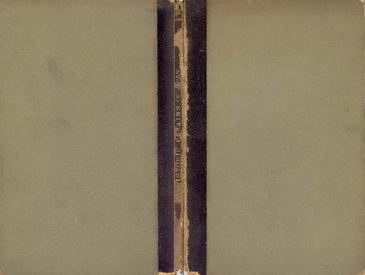|
Milne, John:
Prehistoric Remains, Notes on Stone Implements from Otaru and Hakodate, with a Few General Remarks on the Prehistoric Remains of Japan, Yokohama, an article in the Transactions of the Asiatic Society of Japan, Volume VIII, 1880, 8vo (6 x 9 in), 5 tipped in sepia tone albumen photographs, one engraved drawing and one folding map, pages 61-87. The image areas of the photographs average 3 3/4 x 5 3/4 in. The 5 albumen photographs contain a total of 81 different artifacts - arrow heads, spear points, knives, scrapers, awls, axes, grinding stones, magatma, etc - excavated from sites in Otaru and Hokodate.
Listed in Wenckstern this way:
Milne, J. Notes on stone implements frorm Otaru and Hokodate with a few general remarks on the Prehistoric remains of Japan with 5 plates and plan of Yeddo [Transactions of the Asiatic Society of Japan, vol VIII pp 61-91], 8vo, Yokohama, 1880.
It is clear the actual article ends on page 87. Perhaps the additional pages noted by Wenckstern are pages with comments regarding the article. The description leaves out one plate, probably not counting the woodcut.
John Milne (1850-1913), an English geologist, became a Professor of Geology and Mining at the Imperial College of Engineering in Tokyo in 1877. He has the distinction of being considered one of the founding fathers of modern seismology and the inventor of the modern seismograph capable of continuous recording. He published many scholarly works on seismology while in Japan and is probably best remembered for his works on earthquakes, volcanoes and tsunamis. However, Milne's interests extended in the history of Japan as revealed in the archaeology evidence. In Wenckenstern one finds numerous entries relating to Milne's publications as a geologist/seismologist. On the other hand, his works in archaeology are limited to just three entries. This report given in 1879, an article on "The Stone Age in Japan..." published in England in 1882 and "Notes" on the pit-dwellers of Yezo and the Kurile Islands published in 1882 in Volume X of the Transactions of the Asiatic Society of Japan.
Albumen Photographs. At this time in Japan, the half-tone process for reproducing images for books was not in commercial use. The primary method for low cost reproduction was through black and white woodcut engraving. Other processes available included similar engraving techniques (copper, steel etc), lithography and woodblock processes. This publication has a plate and a map that were produced by the woodcut engraving method. The high quality collotype printing process was not available in Japan at this time. Kasumasa Ogawa, the leader in that form of printing in Japan, would not learn that technique until 1883-4. The only available high quality process to reproduce photograph images at this time was to actually tip in original albumen photographs into the publication. This was a relatively expensive and tedious process and publications at this time with actual tipped in photographs are a striking exception to the norm. Click here for a listing of Japan related books of this nature which I have recorded.
First Page
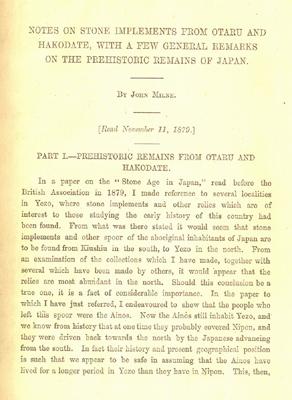
Text Headings
Part I. -- Prehistoric Remains from Otaru and Hakodate
Otaru
I. Pits
II. Inscriptions
III. Mounds and Kitchen Middens
Triangular Arrow heads (Plate I, fig 17-23)
Lancet-shaped Arrow-heads (Plate I, fig 12-16)
Leaf and Spear Type Forms (Plate I, fig 5-8)
Triangular Forms with reentrant Curved Base
(Plate I, fig 9-11)
Scrapers (Plate I, fig 1-3)
Awl (Plate I, Fig 4)
Axes (Plate I, fig 24-9)
Grinding-Stone (Plate V, fig 5)
Chips
Kitchen Middens
Hokodate
Arrow-heads (Plate III, fig 10)
Spear-heads (Plate IV, fig 5-11)
Knives (Plate III, 6-9 & Plate IV, fig 12-17)
Axes or Chisels (Plate III, fig 1,3,13 & Plate IV fig 19-20)
Magatama (Plate III, fig 11).
Other Remains
Conclusion
Part II. General Remarks Upon Prehistoric Remains of Japan
Shell-heaps
Tumuli
Caves
Pit Dwellings
Plates and Map:
Plate I
Tipped in albumen photograph, after page 66.
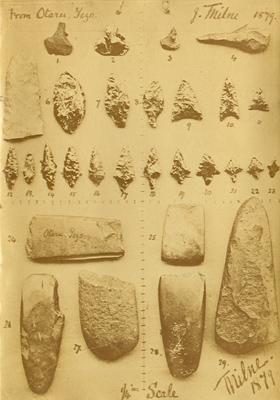
Image Area: 9.6 x 14.8 cm: Number of Figures: 29
Plate II
Tipped in albumen photograph, after page 68.
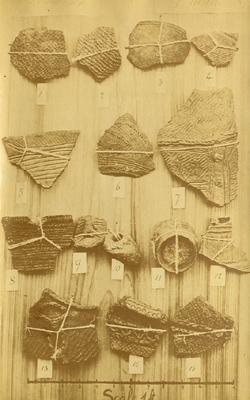
Image Area: 9.5 x 15.2 cm: Number of Figures: 15
Plate III
Tipped in albumen photograph, after page 70.
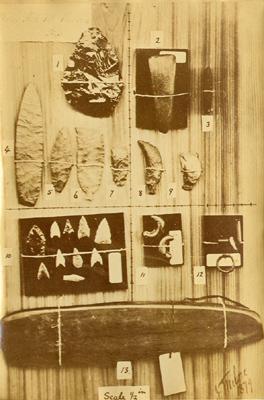
Image Area: 9.6 x 14.5 cm: Number of Figures: 13
Plate IV
Tipped in albumen photograph, after page 71.
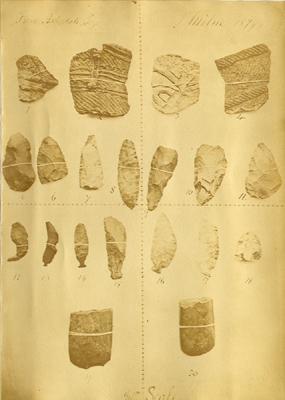
Image Area: 10.4 x 14.5 cm: Number of Figures: 20
Plate V
Tipped in albumen photograph, after plate IV.
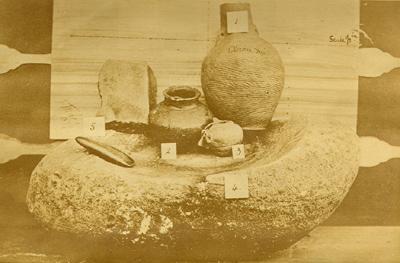
Image Area: 9.6 x 14.5 cm: Number of Figures: 4
Woodcut engraving, after page 64.
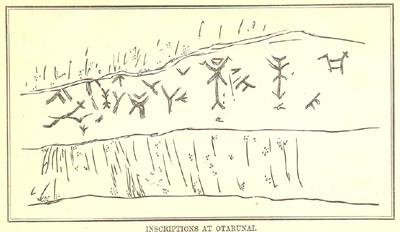
Map (1 fold out), after page 86.
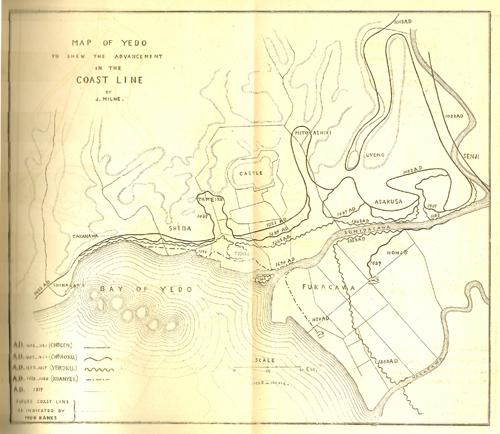
Publications Relating to Japan During the Period from 1860-1882 with Tipped in Albumen Photographs. The practice of illustrating books or articles with albumen photographs during this time period was very limited. As a general rule at this date, illustrations would be created by one of the various engraving techniques (wood, steel etc), lithography or woodblock processes. Publications at this time with actual tipped in photographs are a striking exception to the norm. Below is a listing of the publications using tipped in albumen photographs that I am aware of during this period (ie 1800 through the early 1880s).
- 1860, Westfield, T.C. (Thomas Clark), The Japanese, Their Manners and Customs with an Account of the General Characteristics of the Country, its Manufactures and Natural Productions: Originally Delivered as a Lecture, at the Marylebone Literary and Scientific Institution. This book contained 6 tipped in stereograph photographs. More information here.
- 1864, Wolff, Fr., Album von Ost-Asien Düsseldorf und Mönchen-Gladbach, Ad. Spaarmann, 1864, large 4to, 30 hand color photographic plates, 60 pp (not all photographs are of Japan. here.
- 1868, Felice A. Beato, Native Types and Views of Japan, Photographic Views of Japan with Historical and Descriptive Notes, Compiled from Authentic Sources, and Personal Observations During a Residence of Several Years (with letterpress by James W. Murray and Native Types, Yokohama, 1868. A two volume set. Each volume contains approximately 100 tipped in albumen photographs. More information here.
- 1868, Felice A. Beato, Photographic Images and Customs of Japan, 1868, 4to. More information here.
- 1870-1878, John Reddie Black, The Far East, a periodical first published in Japan and later Hong Kong. More information here.
- 1873, Mittheilungen der Deutschen Gesellschaft fur Natur-Und Volkerkunde Ostasien's. Herausgegeben von dem Vorstande, Part 2 (July 1873) and Part 4 (January 1874) have been confirmed with tipped in albumen photographs. These are the only issues from Part 1 to 6 with tipped in albumen photographs. Is is likely that other issues of the periodical contained tipped to page or plate albumen photographs. For more information on Part 2 and Part 4, click here.
- ca 1877, Stillfried & Andersen, Views and Costumes of Japan, photographic book said to contain 96 albumen photographs taken by Stillfried and Beato. Also reported with 45 albumen photographs. More information here.
- ca 1877, H.H. Bennett, Kilbourn City, Wisconsin, A Summer in Japan. A series of 26 sterographs reproducing images taken by William H. Metcalf when he visited Japan in 1876 or 1877. Albumen photograph stereoviews. Not sold in book form. For more information, click here.
- 1878, Tarumatsu Wada (editor & publisher), Tokaido Gojusan Tsugi. Views of the 53 stages of the Tokaido as depicted in Hiroshige prints on 28 pages of albumen photographs. More information here.
- 1879, various authors, Sashin Shimbun. Illustrated by albumen photographs. More information here.
- 1879, Henry von Siebold, Notes on Japanese Archaeology with Especial Reference to the Stone Age by Henry von Siebold, with 12 Photographic Plates, Typography of C. Levy, containing 12 large sepia tone albumen photographs tipped to plate. More information here.
- 1880, John Milne, Prehistoric Remains, Notes on Stone Implements from Otaru and Hakodate, with a Few General Remarks on the Prehistoric Remains of Japan. An article with 5 tipped in sepia tone albumen photographs. More information here.
- ca 1880, Baron Raimund von Stillfried, Views and Costumes of China and Japan. An album with 70 handcolored albumen photographs. More information here.
- 1882, Thomas Van Buren, Labor in Japan - together with - Pottery and Porcelain Industries of Japan Contains eleven (11) hand colored albumen photographs. More information here.
All the books listed above prior to 1880 are very scarce and seldom seen on the market. None of these publications approached the massive use of albumen photographs seen with The Far East.
In The Advent of Photography in Japan, published jointly by the Tokyo Metropolitan Museum of Photography, Tokyo and the Hakodate Museum of Art, Hokkaido, 1997, the front covers of two issues of the 1871 Far East are shown at page 73. This book served as a guide for exhibits in Tokyo and Hakodate by the same name held in 1997. Each of the covers shown has a tipped in photograph of approximately 40% of the page.
Notes
Early Japan Related Books Illustrated with Tipped in Albumen Photographs.
Note A. (1862)
Westfield, T.C. (Thomas Clark):
The Japanese, Their Manners and Customs with an Account of the General Characteristics of the Country, its Manufactures and Natural Productions: Originally Delivered as a Lecture, at the Marylebone Literary and Scientific Institution, London, Photographic News Office, 1862, 4to. One of the earliest books to contain actual photographs of Japan. These were in the form of six tipped in stereograph photographs. The photographs are attributed variously to A.A.J. Gower (a British consular official), or professional photographers Rossier (French) or W. B. Woodbury (British).
Note B. (1864)
Wolff, Fr.:
Album von Ost-Asien, Düsseldorf und Mönchen-Gladbach, Ad. Spaarmann, 1864, large 4to, 30 hand color photographic plates, 60 pp. Plates include images of Japan, China, British India, Siam and Luzon.
Note C. (1868)
Beato, Felice A.:
Native Types and Views of Japan, Photographic Views of Japan with Historical and Descriptive Notes, Compiled from Authentic Sources, and Personal Observations During a Residence of Several Years (with letterpress by James W. Murray and Native Types, Yokohama, 1868. A two volume set. Each volume contains approximately 100 tipped in albumen photographs. Opposite each photograph is a printed descriptive caption. The Views volume is entirely black and white while the Types volume contains hand colored albumen photographs. Beato's use of artists to hand color photographs was a pioneering effort which would rapidly expand over the next 30 years. Charles Wirgman, the noted artist and satirist, is said to have colorized many of the photographs for these books. James W. Murray, who provided the descriptive text for the photographs, was a noted author of travel guides for Japan. The albums were very expensive and cost the equivalent of $200 at the time. Many of the images have vignetted edges which was typical of Beato's work. In 1877 Beato sold his studio to Baron Stillfried. You often see Beato's photographs with English titles added to the negative by Stillfried.
Note D. (1868)
Beato, Felice A.:
Photographic Images and Customs of Japan, 1868, 4to. A photographic type album of mounted hand tinted albumen prints that have the information relating to the image attached verso. One photograph is titled "Sentence" and shows a condemned man affixed to a cross.
Note E. (1868)
Stillfried-Ratenicz, Baron Raimund von,
Andersen, H.:
Views and Costumes of Japan, photographic book said to contain 96 albumen photographs taken by Stillfried and Beato. The book is oblong folio (19.5 x 24.4 cm). The majority of the photographs are hand colored and some have the number or titles in the image and some with have titles written in pencil below the image. Mounted on pages front and back. There is a albumen frontispiece titled "Views & Costumes of Japan by Stillfried & Andersen, Yokohama." I have also seen this book described with 45 albumen photographs (23 colored, 22 black and white). While not dated the approximate date of the book can be determined from know facts. The Stillfried and Andersen association ran from 1876 through 1879. That firm took over Beato's stock of photographs in 1877 and they were used extensively in this book. While the publication date is approximated as 1877, the photographs are generally from mid-1860s through the early 1870s when Beato was most active as a photographer.
Note F. (ca1877)
Stillfried-Ratenicz, Baron Raimund von
Andersen, H.:
Views and Costumes of Japan, photographic book said to contain 96 albumen photographs taken by Stillfried and Beato. The book is oblong folio (19.5 x 24.4 cm). The majority of the photographs are hand tinted and some have the number or titles in the image and some with have titles written in pencil below the image. Mounted on pages front and back. There is a albumen frontispiece titled "Views & Costumes of Japan by Stillfried & Andersen, Yokohama." I have also seen this book described with 45 albumen photographs (23 colored, 22 black and white). While not dated the approximate date of the book can be determined from know facts. The Stillfried and Andersen association ran from 1876 - 1879. That firm acquired took over Beato's stock of photographs in 1877 and they were used extensively in this book. While the publication date is approximated as 1877, the photographs are generally from mid-1860s through the early 1870s when Beato was most active as a photographer.
Note G. (1878)
Wada, Tarumatsu (editor & publisher):
Tokaido Gojusan Tsugi, Japan, Tarumatsu Wada, 1878, photographic (albumen) views of the 53 stages of the Tokaido as depicted in Hiroshige prints, 10 x 6 cm. The views are shown in 28 pages of albumen photographs. Wooden boards with title in ink on front and back.
Note H. (1879)
Various authors:
Sashin Shimbun, Zenshin-sha, 1879, contained tipped in albumen photographs. The publication had a short life span of only approximately 10 issues.
Note I. (1879)
von Siebold, Heinrich Philipp (Henry):
Notes on Japanese Archaeology with Especial Reference to the Stone Age by Henry von Siebold, with 12 Photographic Plates, Typography of C. Levy, Yokohama, typography (text) by C. Levy, 1879, 4to (9 1/2 x 13 3/4 in - 24.5 x 36 cm), printed paper covered boards with green cloth spine, preface (I-III), 12 albumen photograph plates, 22 pages of text. The last four pages of the text (pages 19-22) contain tables titled "Explanation of Photographic Table" These tables provide the details regarding of the 285 items pictured and numbered in the plates. The plates are composed of original sepia tone albumen photographs tipped to card stock. The individual photographs can be characterized as large size photographs, approximately 7 1/2 x 9 1/2 inches (or slightly larger) each. Above each photograph is a tipped on heading indicating the "Table" (Plate) number. Each object shown in the photograph is identified by a small manuscript number etched in white adjacent to it. These numbers correspond to the detailed information found in the four pages of "Explanation of Photographic Table" found in the text portion of the book. For more information on this book, including pics of 11 of the 12 photographs, click here.
Note J. (1880)
Milne, John:
Prehistoric Remains, Notes on Stone Implements from Otaru and Hakodate, with a Few General Remarks on the Prehistoric Remains of Japan, Yokohama, extracted from Transactions of the Asiatic Society of Japan, Volume VIII, 1880, 8vo, 5 tipped in sepia tone albumen photographs, one engraved drawing and one folding map, pages 61-87. For more information on this article, click here.
Note K. (ca 1880)
von Stillfried, Baron Raimund:
Views and Costumes of China and Japan, Yokohama, not dated (ca 1880), album with 70 handcolored albumen photographs. The front cover is a montage. Photographs generally measure 7 1/2 x 9 1/2 in and are mounted on heavy card stock and protected by tissue guards. Images fall into the following general areas: Enshima (1), Nagasaki (11), Papenberg (4), Sofkudji (1), Fukuya (1), Tenodji (1), Megane-Bashi (1), Kiyomidzo (2), Choin (1), Honwandji (2), Ketang (2), Karasaki (1), Ishiyama (2), Nari (5), Kanasawa (1), Daibutz (2), Hasse (1), Tomioka (1), Tokaido (1), Mandarin Bluff (1), Kiga (1), Goten (2), Fusiyama (2), Nikko (8) Saruhashi (1), Yumoto (4), Asayama (2) Shua (2), Fukiage (1), Asakuja (1), Odji (1) and Uyendo (2). Baron von Stillfried lived in Japan 1867-1883. While he was an accomplished photographer, he also purchased the stock of Felice Beato in 1877 and the merger of the Beato stock with his work/stock complicates identification of his works.
Note L. (1882)
Van Buren, Thomas B.:
Labor in Japan - together with - Pottery and Porcelain Industries of Japan, Yokohama, Japan, Printed at the Japan Gazette Office, 1882, 8vo (6 1/4 x 9 in - 15.7 x 23.3 cm), 59 pp + 10 pp. Contains eleven (11) hand colored albumen photographs of 1) His Imperial Majesty, Mutsu Hito, Emperor [Meiji], 2) Her Imperial Majesty, Empress Haruko, 3) Ainos, 4) Samurai Warrior, 5) Coolie, 6) Geisha, 7) Vegetable Peddler, 8) Girl in Winter Dress, 9) Coolie in Winter dress, 10) Satsuma Vase, and 11) Kutani Plate. Prepared by Thomas B. Van Buren, the U.S. Consul-General in Japan. This book contains two reports which were originally printed in the Reports of the Consuls of the United States, No. 2, November, 1880, published by the Department of State. The reports as published by the US Government have been slightly modified (corrected) and supplemented with eleven (11) albumen photographs interspersed in the text. The photographs of the Meiji Emperor and Empress in this book are scarce early images. For more information on this book, click here. Van Buren held office from June 1874 until June 1885.
|

